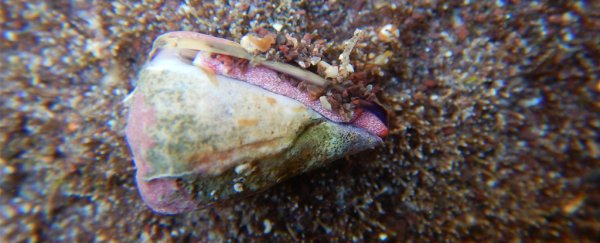For something that's so dangerous to humans – even fatal sometimes – the toxin-laced venom of the cone snail is a wonderful contradiction of the natural world.
Scientists have been discovering for years that the venomous 'sting' of these armoured sea snails contains curious compounds that appear to have powerful medicinal potential – with applications that could help us treat cancer, develop new kinds of painkillers, and maybe combat all kinds of diseases.
Now, another such use case has been identified – malaria, a scourge that affects hundreds of millions of lives annually.
In a new study, scientists found that that molecular components of cone snail venom have the ability to treat severe cases of malaria, by inhibiting the activity of Plasmodium falciparum, the protozoan parasite that causes one type of the disease.
"Among the more than 850 species of cone snails there are hundreds of thousands of diverse venom exopeptides that have been selected throughout several million years of evolution to capture their prey and deter predators," says biochemist Frank Marí from the National Institute of Standards and Technology in Maryland.
"This immense biomolecular library of conopeptides can be explored for potential use as therapeutic leads against persistent and emerging diseases affecting non-excitable systems."
In the new study, led by first author Alberto Padilla from Florida Atlantic University (FAU), the researchers were interested in one cone snail in particular, the species Conus nux.
Collecting specimens of the sea snail off the Pacific coast of Costa Rica, the researchers analysed the makeup of its toxins, which, in the case of cone snails, are termed conotoxins: neurotoxic peptides that specifically target surface proteins of cells, sometimes to disastrous effect for animals on the wrong end of C. nux.
But the mysterious mechanisms underlying the cone snail's venom could also have vast therapeutic potential, scientists think.
"Conotoxins have been vigorously studied for decades as molecular probes and drug leads targeting the central nervous systems," says FAU biomedical scientist Andrew Oleinikov.
In the case of severe malarial infections due to P. falciparum, the problem to solve is one of adhesion – specifically, finding a way to prevent cytoadhesion of infected blood cells (aka erythrocytes), which persists even after the parasites have been killed by drug treatment.
"Cytoadherence between P. falciparum-infected erythrocytes (IE) and host receptors is the key factor in P. falciparum virulence," the researchers write in their new paper.
"Looking for new avenues to prevent adherence of P. falciparum IE to receptors in the vasculature can make current and future chemotherapies more effective and contribute to overcoming the challenge of fast development of drug resistance demonstrated by P. falciparum."
As it happens, C. nux is our friend here. In the researchers' tests of the cone snail's venom, they identified six 'fractions' in the venom that can disrupt the protein interactions promoting cytoadhesion in IE cells, specifically by inhibiting an erythrocyte membrane protein called PfEMP-1.
While these results have so far only been seen in the lab, the researchers say the discovery could help pave the way to future pharmaceuticals that might treat severe cases of malaria – and potentially other diseases that depend upon similar forms of protein-based bindings, including cancer, AIDS, and COVID-19.
"These findings expand the pharmacological reach of conotoxins/conopeptides by revealing their ability to disrupt protein-protein and protein- polysaccharide interactions that directly contribute to the disease," the authors write.
"This lead can provide new avenues to explore the use of venom peptides in the potential treatment of countless diseases that can be mitigated by blockage therapies."
The findings are reported in Journal of Proteomics.
